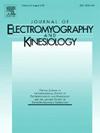Strength and endurance of the lumbar extensor muscles and their predictors: A cross-sectional study in healthy subjects
IF 2.3
4区 医学
Q3 NEUROSCIENCES
引用次数: 0
Abstract
The purpose of this cross-sectional study was to present the values of maximal isometric lumbar extensor muscle strength (MILEMS) and lumbar extensor muscle endurance (LEME) in healthy subjects and to study the influence of physiological factors on these parameters. MILEMS using a hand-held dynamometer in three positions (prone, sitting, standing) and LEME using the Biering-Sørensen test were assessed in 115 healthy volunteers. The MILEMS measurements for the specific positions were correlated with each other (Pearson correlation coefficients 0.31–0.87, p < 0.001). In univariable linear regression, sex showed the highest effect on MILEMS prediction in sitting position (higher strength in men, P < 0.001, R2 of 20.4 %). Multivariable linear regression led to construction of a calculator to estimate predicted MILEMS in the sitting position in relation to sex, age and BMI with R2 of 32.2 %. LEME was mostly predicted by BMI (decrease of LEME with increasing BMI, P < 0.001), but multivariable regression analysis did not allow the construction of a reliable calculator to predict this parameter. In conclusion, we provided values for MILEMS and LEME. A calculator was developed to predict MILEMS and to determine the percentile of measured MILEMS in an individual. It is expected to be particularly useful in assessing patients who are likely to have lumbar extensor muscle impairment.
腰伸肌的力量和耐力及其预测因素:健康受试者的横断面研究
本横断面研究的目的是了解健康受试者最大等肌伸肌力量(MILEMS)和腰伸肌耐力(LEME)的值,并研究生理因素对这些参数的影响。对115名健康志愿者进行了三种体位(俯卧、坐姿、站立)使用手持式测功机的MILEMS和使用biering - s - ørensen试验的LEME评估。特定位置的MILEMS测量结果彼此相关(Pearson相关系数为0.31-0.87,p 2为20.4%)。多变量线性回归构建了一个计算器来估计与性别、年龄和BMI相关的坐姿预测MILEMS, R2为32.2%。LEME主要由BMI预测(LEME随BMI升高而降低,P
本文章由计算机程序翻译,如有差异,请以英文原文为准。
求助全文
约1分钟内获得全文
求助全文
来源期刊
CiteScore
4.70
自引率
8.00%
发文量
70
审稿时长
74 days
期刊介绍:
Journal of Electromyography & Kinesiology is the primary source for outstanding original articles on the study of human movement from muscle contraction via its motor units and sensory system to integrated motion through mechanical and electrical detection techniques.
As the official publication of the International Society of Electrophysiology and Kinesiology, the journal is dedicated to publishing the best work in all areas of electromyography and kinesiology, including: control of movement, muscle fatigue, muscle and nerve properties, joint biomechanics and electrical stimulation. Applications in rehabilitation, sports & exercise, motion analysis, ergonomics, alternative & complimentary medicine, measures of human performance and technical articles on electromyographic signal processing are welcome.

 求助内容:
求助内容: 应助结果提醒方式:
应助结果提醒方式:


